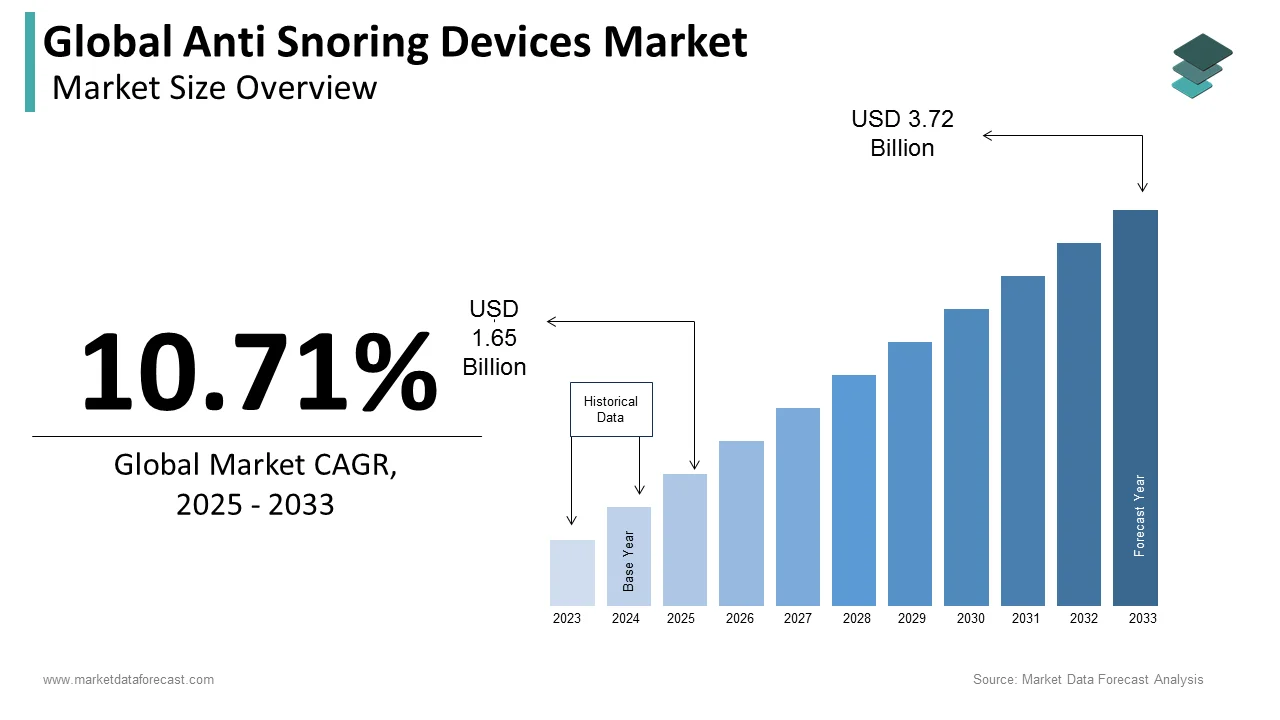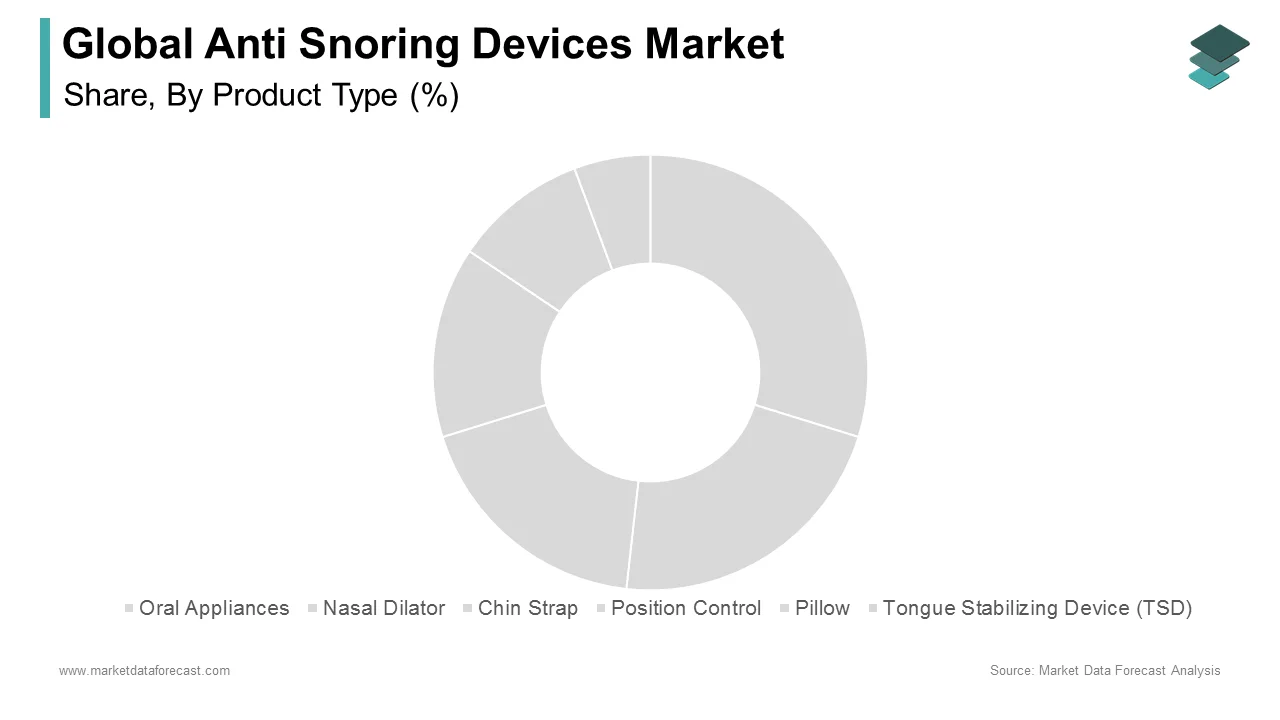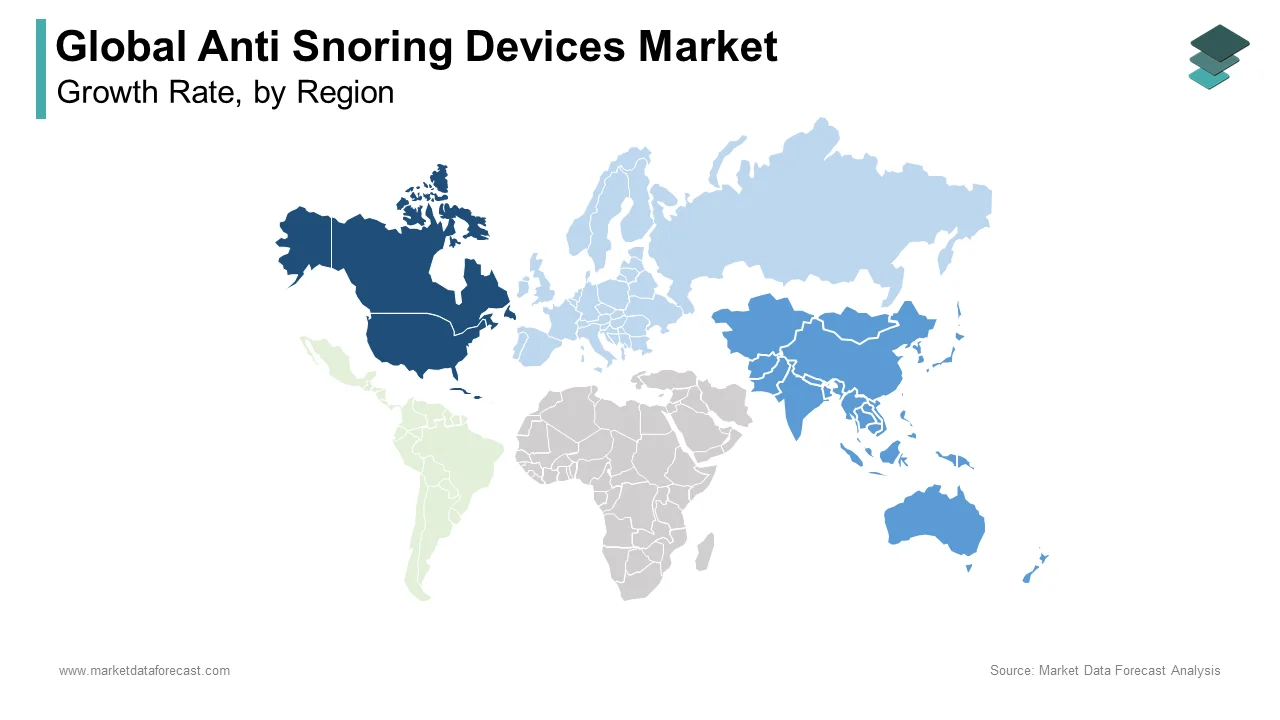Global Anti Snoring Devices Market Size, Share, Trends & Growth Forecast Report By Device Type (MADs, TRD, Nasal Dilator, Chin Strap, Position Control, Pillows, TSD, EPAP), Surgical Procedure (UP3, LAUP, RFA, Sclerotherapy, Pillar, Others (Septoplasty, ESS)) and Region (North America, Europe, Asia-Pacific, Latin America, Middle East and Africa), Industry Analysis From 2025 To 2033.
Global Anti Snoring Devices Market Size
The size of the global anti snoring devices market was worth USD 1.5 billion in 2024. The global market is anticipated to grow at a CAGR of 10.71% from 2025 to 2033 and be worth USD 3.72 billion by 2033 from USD 1.65 billion in 2025.

MARKET DRIVERS
The growing incidence of obesity among people throughout the world is expected to boost the global anti snoring devices market.
According to the National Sleep Foundation, 90 million adults were affected by snoring in 2017, and 37 million breathed regularly. Also, body mass index (BMI) increases in middle-aged people at the highest risk of health complications. According to the World Health Organization (WHO), the obese population tripled between 1975 and 2016. As per WHO, in 2016, more than 1.9 billion adults were overweight, and more than 650 million were obese. Over 40 million children under the age of 5 were overweight or obese.
The growing aging population, increased smoking and alcohol consumption, technological advances in snoring prevention devices, and increased awareness in developed markets are key drivers of market growth. The economic impact of sleep apnea can be particularly high because of the high cost of medical care for patients associated with CVD. Medtronic dominated the market share, followed by GE Healthcare and Philips in 2020. Together, these companies dominate the global snoring device and snoring surgery market with a market share of over 70%.
The rise in tobacco and alcohol consumption and heightened awareness of the negative consequences of snoring from these factors drive the anti snoring devices market growth.
Throughout the forecast period, technological developments in the market fuel the global anti-snoring devices market. Besides, low-cost and less invasive devices, in conjunction with related product advantages, may fuel demand. Another effect-making factor is the increased incidence of obesity, diabetes, and other chronic diseases. Besides, increasing the geriatric population base vulnerable to obesity positively impacts the growth of the demand for anti-snoring products. The increasing patient propensity to anti-snoring devices will fuel demand for such devices boosting the market for anti-snoring devices. Also, increasing awareness of the adverse effects of snoring, increased alcohol and tobacco use, increased disposable income, and advanced product development are critical factors that fuel the demand for anti-snoring devices in the years to come.
MARKET RESTRAINTS
The high cost of surgeries, the limited effectiveness of treatments currently available in this condition, and the unfavorable reimbursement issues can impede the growth of the anti-snoring market. Also, the drawbacks associated with using non-surgical devices such as dry mouth, jaw discomfort, and excessive salivation act as powerful obstacles to their use by patients.
REPORT COVERAGE
|
REPORT METRIC |
DETAILS |
|
Market Size Available |
2024 to 2033 |
|
Base Year |
2024 |
|
Forecast Period |
2025 to 2033 |
|
Segments Analysed |
By Product Type, Surgical Procedure, and Region |
|
Various Analyses Covered |
Global, Regional & Country Level Analysis, Segment-Level Analysis, Drivers, Restraints, Opportunities, Challenges, PESTLE Analysis, Porter’s Five Forces Analysis, Competitive Landscape, Analyst Overview on Investment Opportunities |
|
Regions Analysed |
North America, Europe, Asia Pacific, Latin America, Middle East, and Africa |
|
Key Market Players |
Sleeping Well LLC, Apnea Sciences Corporation, Tomed Dr. Toussaint Gmbh, AccuMED Corp., Fisher & Paykel Healthcare, Apnea Sciences Corporation, ImThera Medical Inc., ResMed Inc., SomnoMed, Sleep Well Enjoy Life, Ltd., MEDiTAS Ltd., and Nasal Devices. |
SEGMENTAL ANALYSIS
By Product Type Insights

The oral appliances segment accounts for the largest share of the anti-snoring devices market during the forecast period, followed by the nasal devices segment. The oral appliances segment is also predicted to witness the highest CAGR during the forecast period. The increased awareness among healthcare professionals regarding the effectiveness of oral appliances in reducing snoring and managing mild to moderate obstructive sleep apnea primarily drives the growth of the oral appliance segment. The non-invasive and user-friendly nature of oral appliances, growing awareness about the health risks associated with snoring, such as sleep apnea and cardiovascular problems and increasing popularity of oral appliances as an accessible and convenient option for individuals seeking relief from snoring and associated sleep disturbances further boost the growth rate of the oral appliances segment in the global anti-snoring devices market.
The nasal dilator segment is estimated to account for a notable share of the global market during the forecast period. The non-invasive and drug-free approach of nasal dilators to manage snoring without medication or surgery primarily fuels the demand for these devices and drives segmental growth. Nasal dilators are easy to use and do not interfere with sleep positions and due to these benefits, the adoption of these devices is on the rise worldwide and propelling segmental growth. Nasal dilators are suitable for individuals seeking minimalistic and comfortable solutions for snoring and widely available over-the-counter products for easy accessibility, which further contribute to segmental growth.
By Surgical Procedure Insights
The RFA segment is estimated to capture the leading share of the global anti-snoring devices market during the forecast period. The growing preference for minimally invasive procedures with shorter recovery times and reduced post-operative discomfort is one of the major factors propelling the growth of the RFA segment in the worldwide market. Radiofrequency ablation offers a targeted approach to shrink and stiffen the tissues in the throat, reducing airway obstruction and improving breathing during sleep. Technological advancements in RFA devices, such as temperature-controlled and impedance-controlled systems and rising awareness about the effectiveness of RFA in reducing snoring and improving sleep quality further boost the growth rate of the RFA segment in the global market.
The Uvulopalatopharyngoplasty (UP3) segment is expected to hold a considerable share of the global market during the forecast period owing to the growing prevalence of snoring and sleep-related breathing disorders. The growing number of advancements in surgical techniques, such as laser-assisted uvulopalatopharyngoplasty (LAUP) and modified procedures and rising awareness about the potential health risks associated with untreated snoring and sleep apnea further promote segmental growth.
REGIONAL ANALYSIS
North America accounted for the major share of the global market in 2024. The North American anti-snoring devices market is estimated to grow at a healthy CAGR during the forecast period.
Factors such as the high prevalence of snoring and sleep-related breathing disorders in the North American region, the presence of a well-established healthcare infrastructure and advanced diagnostic capabilities and growing awareness about the health risks associated with untreated snoring and sleep apnea drive the demand for anti-snoring devices and propel the North American market growth. The strong presence of key market players and continuous technological advancements in the region and favorable reimbursement policies for anti-snoring devices and related procedures further fuel the growth rate of North American market. The United States market for anti-snoring devices had the major share of the North American market in 2024 and the domination of the U.S. in the North American market is likely to continue in the forecast period. Factors responsible for this large proportion are the harmful effects of the disease, the presence of multiple actors in the sector, and the increasing awareness of the sick untapped population. With the negative impact of snoring and raising awareness among many market participants, North America will dominate the global market for anti-snoring devices and operations during the forecast period. North America and Europe are the fastest-growing regions of the global market for snoring prevention and snoring due to the large number of patients and the prevalence of obesity.
The Asia-Pacific region is anticipated to witness the highest CAGR during the forecast period owing to the increasing awareness about snoring-related health risks, growing disposable income and improving access to healthcare in countries like China and India, driving the demand for anti-snoring devices. The rapid adoption of Western lifestyles, technological advancements and increasing investments in healthcare infrastructure and an increasing number of initiatives from the governments of APAC countries to raise awareness about sleep disorders and the importance of treatment further boost the growth rate of the APAC market. China, Japan and India are anticipated to control the leading share of the APAC market during the forecast period.
Europe was the second-largest regional market for anti-snoring devices worldwide and is predicted to showcase a healthy CAGR during the forecast period. The growing awareness about snoring-related health issues and sleep disorders among the population, rising emphasis on sleep medicine and the availability of specialized sleep clinics and centers and rapid adoption of innovative anti-snoring devices and advancements in technology primarily propel the European market. The growing efforts from the governments of European countries to promote sleep health and raise awareness about snoring disorders and collaborative efforts by healthcare organizations, sleep societies, and market players to address snoring-related problems further fuel the growth rate of the European market. The UK, Germany and Italy are expected to play the leading role in the European market in the coming years.
Latin America is expected to account for a considerable share of the global market during the forecast period owing to the increasing number of improvements in the healthcare infrastructure and access to diagnostic services, growing awareness about the impact of snoring on overall health and quality of life and the availability of a range of anti-snoring devices at various price points.
The MEA is projected to register a steady growth rate during the forecast period owing to the growing awareness about the health risks associated with snoring and sleep apnea and the increasing prevalence of obesity and lifestyle factors contributing to snoring disorders.
KEY MARKET PLAYERS
List of top companies leading the global anti-snoring devices market profiled in this report are Sleeping Well LLC, Apnea Sciences Corporation, Tomed Dr. Toussaint Gmbh, AccuMED Corp., Fisher & Paykel Healthcare, Apnea Sciences Corporation, ImThera Medical Inc., ResMed Inc., SomnoMed, Sleep Well Enjoy Life, Ltd., MEDiTAS Ltd., and Nasal Devices.
RECENT HAPPENINGS IN THE MARKET
- Tomed introduced SomnoBelt, an anti-snoring belt in the chest that prevents supine sleep and disables snoring by providing the right night sleep position.
- In early 2015, Meditas Limited introduced nasal dilators for the continuous flow of air. An unobtrusive nasal system that adds into the nostril where, by opening the air passage, it facilitates ventilation by increasing resistance to incoming air. The extra oxygen received with Nasal Dilators enables people to breathe deeply and much less often.
- In mid-2015, Zimmer Holdings Inc. acquired Biomet and announced they would combine to dominate the markets to counter disruptive small and medium-sized producers. A broad and diverse portfolio of musculoskeletal solutions will be available to the company. Zimmer Biomet's size would ensure greater competition in core franchises and a more substantial presence in emerging markets.
MARKET SEGMENTATION
This research report on the global anti-snoring devices market has been segmented and sub-segmented based on product type, surgical procedure, and Region.
By Product Type
- Oral Appliances
- Mandibular Advancement Devices (MADs)
- Tongue Retaining Devices (TRD)
- Nasal Dilator
- Chin Strap
- Position Control
- Pillow
- Tongue Stabilizing Device (TSD)
- EPAP
By Surgical Procedure
- Uvulopalatopharyngoplasty (UP3)
- Laser-Assisted Uvula Palatoplasty (LAUP)
- Radiofrequency Ablation (RFA)
- Sclerotherapy
- Pillar
- Others
By Region
- North America
- Europe
- Asia Pacific
- Latin America
- The Middle East and Africa
Frequently Asked Questions
What is the current size of the anti-snoring devices market?
The global anti-snoring devices market was valued at USD 1.5 billion in 2024.
What are the main factors driving growth in the anti-snoring devices market?
The growing awareness of the health risks associated with snoring, rising demand for non-invasive snoring solutions, and a growing elderly population are majorly propelling the growth of the anti-snoring devices market.
Who are the key players in the anti-snoring devices market?
Sleeping Well LLC, Apnea Sciences Corporation, Tomed Dr. Toussaint Gmbh, AccuMED Corp., Fisher & Paykel Healthcare, Apnea Sciences Corporation, ImThera Medical Inc., ResMed Inc., SomnoMed, Sleep Well Enjoy Life, Ltd., MEDiTAS Ltd., and Nasal Devices are some of the notable companies in the anti-snoring devices market.
Related Reports
Access the study in MULTIPLE FORMATS
Purchase options starting from $ 2500
Didn’t find what you’re looking for?
TALK TO OUR ANALYST TEAM
Need something within your budget?
NO WORRIES! WE GOT YOU COVERED!
Call us on: +1 888 702 9696 (U.S Toll Free)
Write to us: [email protected]

